MUSIC PAPER 1 GRADE 12 MEMORANDUM - NSC PAST PAPERS AND MEMOS FEBRUARY/MARCH 2018
Share via Whatsapp Join our WhatsApp Group Join our Telegram GroupMUSIC
PAPER 1
GRADE 12
NSC PAST PAPERS AND MEMOS
FEBRUARY/MARCH 2018
INSTRUCTIONS AND INFORMATION
- This question paper consists of FIVE sections, namely SECTIONS A, B, C, D and E.
- SECTIONS A and B are compulsory.
- SECTION C: WESTERN ART MUSIC (WAM), SECTION D: JAZZ and SECTION E: INDIGENOUS AFRICAN MUSIC (IAM) are choice questions. Answer only ONE of these sections (SECTION C or D or E).
- Write all music notation in SECTION A in pencil and all written text in blue or black ink on this question paper.
- Answer SECTION B and SECTION C or D or E in blue or black ink in the ANSWER BOOK provided.
- Number the answers correctly according to the numbering system used in this question paper.
- The last page of this question paper is manuscript paper intended for rough work. Candidates may remove this page.
- Candidates may NOT have access to any musical instrument for the duration of this examination.
- Candidates must take note of the mark allocation of each question in order to provide enough information in their answer.
- Write neatly and legibly.
MARKING GRID
SECTION | QUESTION | MARKS | MARKER | MODERATOR |
A: THEORY OF MUSIC (COMPULSORY) | 1 | 20 | ||
2 | 15 | |||
3 | 10 | |||
4 | 15 | |||
SUBTOTAL | 60 |
|
| |
AND | ||||
B: GENERAL (COMPULSORY) | 5 | 20 | ||
SUBTOTAL | 20 |
|
| |
AND | ||||
C: WAM | 6 | 10 | ||
7 | 5 | |||
8 | 5 | |||
9 | 5 | |||
10 | 15 | |||
SUBTOTAL | 40 |
|
| |
OR | ||||
D: JAZZ | 11 | 10 | ||
12 | 5 | |||
13 | 5 | |||
14 | 5 | |||
15 | 15 | |||
SUBTOTAL | 40 |
|
| |
OR | ||||
E: IAM | 16 | 10 | ||
17 | 5 | |||
18 | 5 | |||
19 | 5 | |||
20 | 15 | |||
SUBTOTAL | 40 |
|
| |
| ||||
GRAND TOTAL | 120 |
|
| |
MEMORANDUM
SECTION A: THEORY OF MUSIC (COMPULSORY) (90 minutes)
Answer QUESTION 1
AND QUESTION 2.1 OR 2.2
AND QUESTION 3.1 OR 3.2
AND QUESTION 4.1 OR 4.2.
Answer the questions in the spaces provided on this question paper.
QUESTION 1 (25 minutes)
Study the extract from Send in the Clowns by Stephen Sondheim below and answer the questions that follow.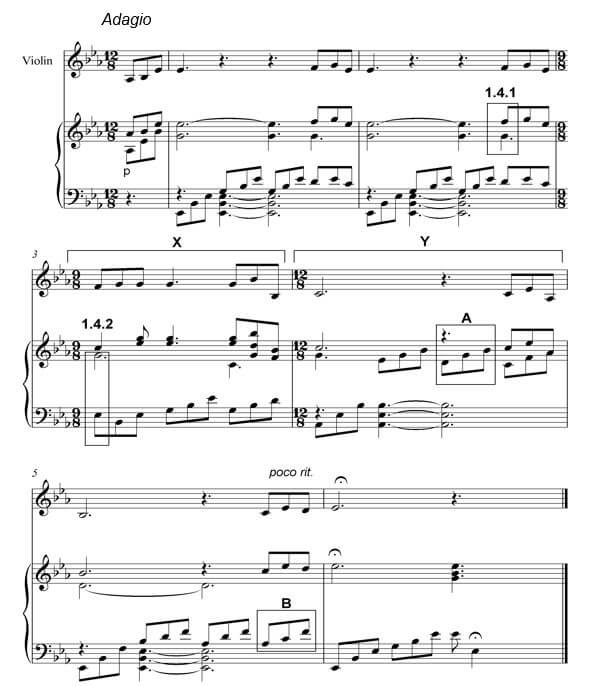
1.1 Name the key of the work.
Answer:
- Eb major = 1 mark (1)
1.2 What is the relative minor of the main key?
Answer:
- C minor = 1 mark (1)
1.3 Transpose the first four notes of the violin part a major third higher on the given stave below. Use a new key signature.
Answer  (2)
(2)
| Key signature = 1 mark Notation = 1 mark (Minus ½ mark per mistake to a maximum of 1 mark) (No penalisation if time signature is left out) |
1.4 Name the intervals at 1.4.1 and 1.4.2 according to type and distance.
Answer:
1.4.1 Minor 7th
1.4.2 Major 10th/Compound Major 3rd (2)
| 1 mark each 1.4.2 Major 3rd only = ½ mark No mark for distance only |
1.5 Name the triads at A and B according to type and position, for example Major, second inversion. (Consider only the notes in the block.)
Answer:
A: Minor second inversion
B: Minor first inversion (2)
| Type= ½ mark each Position = ½ mark each (4 x ½) = 2 |
1.6 Rewrite the violin part at X using half the note values. Insert the new time signature.
Answer: (2)
(2)
| Time signature= 1 mark Notation= 1 mark (Minus ½ mark per error up to 1 mark) |
1.7 Rewrite the violin part at Y in the corresponding simple quadruple time, using the alto clef.
Answer: (3)
(3)
| Clef = 1 mark Time signature = 1 mark Notation = 1 mark (Minus ½ mark per error up to 1 mark) |
1.8 Give the meaning of the Italian term, Adagio.
Answer:
(1)
| Slow (tempo) = 1 mark |
1.9 In which scale/mode is the following melody written?
Answer: (1)
(1)
| Blues scale (on E) = 1 mark |
1.10 Write the melodic form of the B minor scale, descending, using the alto clef. Write without a key signature, use semibreves and mark the semitones.
Answer:
 (3)
(3)
| Clef = 1 mark Semitones = ½ mark each = 1 mark Notation = 1 mark (Minus ½ mark per error up to a maximum of 1 mark) |
1.11 Complete the fragment by writing sequences of motif (a) in bars 2 and 3.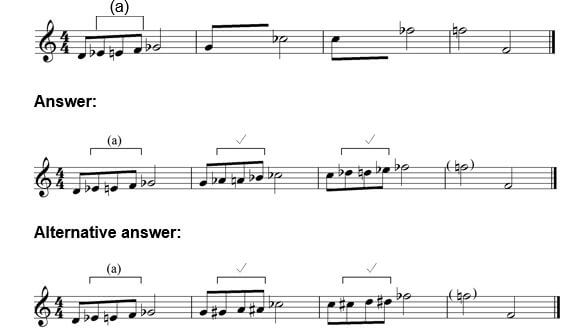
| 1 mark per sequence = 2 marks (Minus ½ mark per mistake up to a maximum of 2 marks) Any correct chromatic spelling must be accepted |
(2)
[20]
QUESTION 2 (25 minutes)
Answer EITHER QUESTION 2.1 OR QUESTION 2.2.
2.1 Complete the opening motif below to form a twelve-bar melody in ternary form for any single-line melodic instrument of your choice. Name the instrument for which you are writing. Indicate the tempo and add dynamic and articulation marks.
Concept answer:
Instruments: Bassoon, Trombone, Cello, Bass guitar, Double bass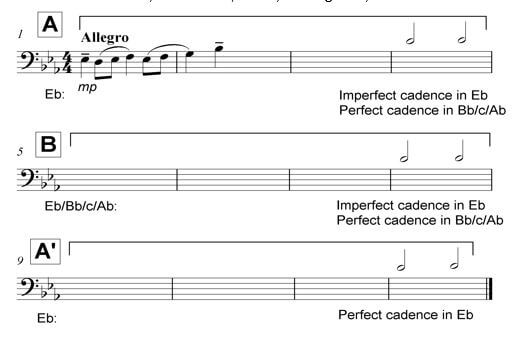
OR
2.2 Concept answer:
Instrument: Flute, Oboe, Clarinet, Trumpet, Violin, Guitar, Saxophone, Marimba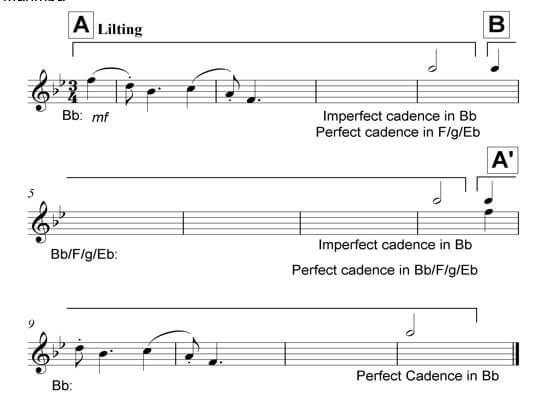
The melody will be marked according to the following criteria:
DESCRIPTION | MARK ALLOCATION | ||
Form and cadential points | 1 mark per phrase x 3 | 3 | |
Correctness | Minus ½ mark per error up to 2 marks | 2 | |
Quality
| 9–10 | Excellent Coherent and musical; phrases imaginatively define the form; opening motif innovatively continued; successful use of tonality; melodic shape masterfully handled; creative approach to choice of pitches and rhythm | 10 |
7–8 | Good Correct and musical; phrases clearly indicate the form; opening motif sensibly continued; stable tonality; melodic shape satisfying; choice of pitches and rhythm accurate | ||
4–6 | Average Musically not convincing; not all phrases clear; opening motif not well utilised; tonality unstable; melodic shape is suspect; choice of pitches and rhythm unimaginative | ||
0–3 | Not acceptable No musical sense; no sense of phrasing; opening motif ignored; no sense of tonal centre; no melodic shape; pitches and rhythm random | ||
TOTAL | Markers may use ½ marks | 15 | |
QUESTION 3 (10 minutes)
Answer EITHER QUESTION 3.1 OR QUESTION 3.2.
3.1 Study the extract below and answer the questions that follow.
Answer: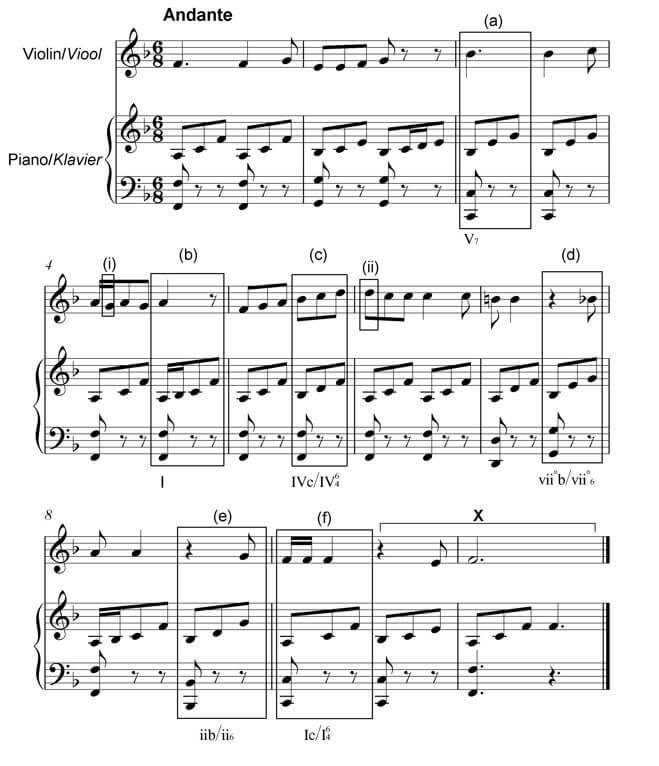
3.1.1 Identify the chords from (a)–(f) and figure them on the score, e.g. iiib/iii6
Answer:
See score: (6)
| 1 mark per chord = 6 marks (Minus ½ mark for each error) (Key indication not compulsory) V only = ½ mark |
3.1.2 Name the type of non-chordal notes at (i) and (ii)
Answer: (2)
| (i) (Lower) Auxiliary note = 1 mark (ii) Suspension = 1 mark |
3.1.3 Identify the cadence at X. Write down the chord progression and the name of the cadence.
Answer:
V7 – I
Perfect (Cadence) (2)
| V7 – I = 1 mark V only = ½ mark Perfect (Cadence) = 1 mark |
[10]
OR
3.2 Study the extract below and answer the questions that follow.
Answer:
3.2.1 Identify the chords from (a)–(f) and figure them on the score, e.g. B/F# (6)
| 1 mark per chord = 6 marks (Key indication not compulsory) If chord symbols are partially correct (e.g. 7th is missing) = ½ mark |
3.2.2 Name the type of non-chordal notes at (i) and (ii)
Answer: (2)
| (i) (Upper) Auxiliary note = 1 mark (ii) Passing note = 1 mark |
3.2.3 Identify the cadence at X. Write down the chord symbols and the name of the cadence.
Answer: (2)
| C7 (½ mark) – F (½mark) = 1 mark Perfect (Cadence) = 1 mark |
[10]
QUESTION 4 (30 minutes)
Answer EITHER QUESTION 4.1 OR QUESTION 4.2.
4.1 Complete the four-part vocal harmonisation below by adding the alto, tenor and bass parts.
Concept answer: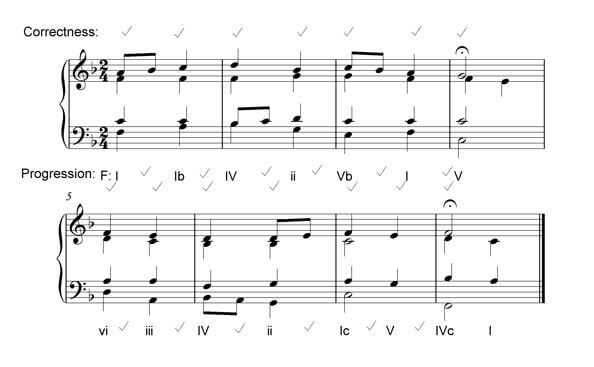
The answer will be marked according to the following criteria:
DESCRIPTION | MARK ALLOCATION | ||
Chord progression | 1 mark between each pair of chords (except between bars 4 and 5) | 12 | |
Correctness | Minus ½ mark per error but not more than 1 mark per chord | 14 | |
Quality |
| = 3½–4 marks | 4 |
| Note to marker:
| 30÷2 = 15 | |
TOTAL |
| 15 | |
OR
4.2 Complete the piece below by adding suitable harmonic material in the open stave. Continue in the style suggested by the given material in bar 1.
Concept answer: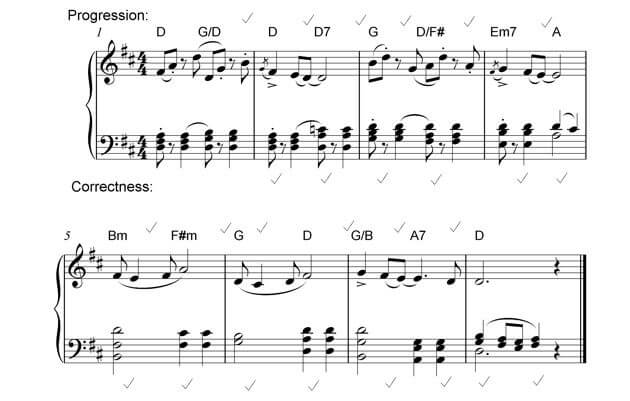
The answer will be marked according to the following criteria:
DESCRIPTION | MARK ALLOCATION | ||
Chord progression | 1 mark between each pair of chords (except between bars 4 and 5) | 12 | |
Correctness | Minus ½ mark per error but not more than 2 marks per bar | 14 | |
Quality |
| = 3½–4 marks | 4 |
| Note to marker: Mark out of 30 must not contain a ½ mark | 30÷2 = 15 | |
TOTAL |
| 15 | |
TOTAL SECTION A: 60
SECTIONS B, C, D, E: GENERAL MUSIC KNOWLEDGE (90 minutes)
Answer SECTION B
AND SECTION C (Western Art Music)
OR SECTION D (Jazz)
OR SECTION E (Indigenous African Music).
Answer these questions in the ANSWER BOOK provided.
SECTION B: GENERAL (COMPULSORY)
QUESTION 5
5.1
5.1.1 C
5.1.2 B
5.1.3 D
5.1.4 D
5.1.5 C
5.1.6 D
5.1.7 C
5.1.8 A
5.1.9 D
5.1.10 C (10)
5.2
| A | B |
5.2.1 | Idiophone | M |
5.2.2 | Ostinato | C |
5.2.3 | Chordophone | A |
5.2.4 | D.C. | N |
5.2.5 | Call and response | L |
5.2.6 | A cappella | K |
5.2.7 | Improvisation | H |
5.2.8 | Ternary form | D |
5.2.9 | Very fast | Q |
5.2.10 | Falsetto | B |
(10) TEN correct answers = 10 marks
[10]
TOTAL SECTION B: 20
Answer SECTION C (WAM)
OR SECTION D (JAZZ)
OR SECTION E (IAM).
SECTION C: WESTERN ART MUSIC (WAM)
QUESTION 6
6.1
6.1.1
- Three large subdivisions: Minuet (A), Trio (B), Minuet (A); Each section (A – aaba; B – ccdc; A aaba); usually in rounded binary form (compound ternary form)
- The Trio (B) is usually different in character and key from Minuet
- A – Tonic, B – Tonic or Related key; A – Tonic (3)
TWO correct facts relating to form = 2 marks
One correct fact relating to key = 1 mark
6.1.2
- ABACA (or ABACADA Old Rondeau)
- The main section or theme, A, returns after each contrasting (B/C) section (episodes)
- A – Tonic, B – Related key (dominant), A – Tonic, C – Related key (relative minor), A - Tonic (3)
TWO correct facts relating to form = 2 marks
One correct fact relating to key = 1 mark
(3 x 2) (6)
6.2
- Dramatic work for voices and orchestral accompaniment
- Combines music, drama, costumes, décor and often dance (2)
1 mark for 'voices and orchestra'
1 mark for idea of 'combination'
6.3 Opera buffa
- Opera with comic subject matter
- Stories often light-hearted and romantic
- The comic characters are from the working class e.g. maids, peasants, servants
Opera seria
- Opera with serious subject matter
- Stories often tragic or heroic
- Typically involves royalty or ancient myths and gods (2)
Correct fact for Opera Buffa = 1 mark
Correct fact for Opera Seria = 1 mark
[10]
QUESTION 7
Form
- Sonata form
- Exposition, Development, Recapitulation, Coda
- Uses a new genre: concert overture
Keys
- Begins in B minor
- Second subject in D major (modulates to relative major)
Harmony
- Uses classical, tonal harmony
Dynamics
- Wide dynamic range: pp to ff
- Expressive use of dynamics to depict nature through sound
Mood
- Brooding mood initially depicting the seascape
- Mood changes according to the suggested program
ONE correct answer from each element = 5 marks [5]
QUESTION 8
Aria: Definition
- An aria written for solo vocalist with instrumental accompaniment
- A song used for stating a particular emotion(s) of a character
TWO correct facts = 2 marks
Mood: Der Hölle Rache
- Depicts a fit of vengeful rage and anger - minor key, fast tempo, ff-dynamics
- Dark impressive mood and dramatic drive – fast tempo, extreme melodic range
- Dramatic flair, theatrical emphasis and spectacle of voice – short melodic phrases, coloratura soprano
THREE correct facts = 3 marks
[5]
QUESTION 9
9.1
A: Hebrides or Fingal's Cave
B: Pastorale Symphony no 6, 1st movement
C: Overture to The Magic Flute (3)
| Correct answers = 3 marks (Answers must be complete – no ½ marks) |
9.2
A: Violas/cellos
B: Violins (2)
| Correct answers = 2 marks |
[5]
QUESTION 10
Programmatic content:
- Given a title: The Pastoral Symphony
- Also published as A recollection of country life
- One of Beethoven's few works containing clear programmatic content
- Its extra-musical purpose is an expression of his love of nature
- All the movements are given a title:
- First movement: Awakening of cheerful feelings upon arriving in the country
- Second movement: Scene by the brook
- Third movement: Happy gathering of country folk
- Fourth movement: Storm
- Fifth movement: Shepherds' song; cheerful and thankful feelings after a storm
- The last three movements are performed as one without pause – to add to the realistic picture of a storm from the emergence, to its climax and then relief at the end
Any SIX correct facts = 6 marks
Instrumentation/Tone painting
- First movement: involves a typical pastoral picture (F major; 6/8) e.g. the opening drone of an open fifth in the lower strings (typical of a 'pastorale)'
- Second movement: includes the famous birdcalls:
- Flute for the nightingale
- Oboe for the quail, and
- Two clarinets for the cuckoo
- Third movement: Typical boisterous, country dance music (Lȁndler) by peasant folk
- Fourth movement: A realistic portrayal of thunder and rain
Uses instruments effectively to imitate storm- Cellos and double basses and timpani - announce the storm
- Staccato sounds of the violins render the falling raindrops
- Timpani - the thunder
- Piccolo contributes the climax and terror of storm
- Arpeggiated figures in the strings – the lightning
- Additional trombones to emphasize the intensity of the storm
- Fifth movement: A remembrance/reflection and continuation of this idealised pastoral scene
- Uses instruments effectively to imitate a calmness of mood
- Returns to F Major (tonal stability) to re- establish the pastoral mood
- Establishes a true paradise, a pastoral scene in its simplicity e.g. yodelling of the clarinet and horn in opening bars, lilting character (in 6/8 time signature)
Any SIX correct facts = 6 marks
The essay will be marked according to the following criteria:
CRITERIA | MARK ALLOCATION | ||
Programmatic content : | 1 mark for each correct fact X 6 | 6 | |
Instrumentation/Tone painting: | 1 mark for each correct fact X 6 | 6 | |
Logical presentation and structure of the essay | Excellent | = 3 marks | 3 |
Good | = 2 marks | ||
Average | = 1½ marks | ||
Below average | = 1 mark | ||
Weak | = ½ mark | ||
Not acceptable | = 0 marks | ||
TOTAL |
| 15 | |
[15]
TOTAL SECTION C: 40
GRAND TOTAL: 120
OR
SECTION D: JAZZ
QUESTION 11
11.1 Melody
- Folk-like melodies - narrow range, largely stepwise
- Blues song character
- Improvisational
Rhythm
- Ghoema beat -
 at a fast tempo (syncopated)
at a fast tempo (syncopated) - Blends African (Xhosa) and Swing elements (2)
Any TWO correct facts, one for each element = 2 marks
11.2
- Solo pennywhistle playing
- Moderate to upbeat tempo
- Skiffle-like beat
- Jive/Swing rhythms -
pattern repeated constantly
- Weaving of different melody lines together
- Melody developed through improvisation (4)
Any FOUR correct facts = 4 marks
11.3
11.3.1 Marabi
11.3.2 Mbaqanga
11.3.3 Cape Jazz
11.3.4 New Jazz/Jazz in Exile (4)
| Correct answers = 4 marks |
[10]
QUESTION 12
Dolly Rathebe
- Contributed to African vocal jazz styles
- Contributed to the developing Afro-pop genre
- Popularised local African songs/compositions
- Contributed to South African protest music
- Incorporated the American swing idiom with lyrics in African languages
- Woza (1991) or A Call for Peace (1995) or Siya Gida – We dance (1997)
Any FIVE correct facts = 5 marks
Thandi Klaassen
- Forming of the first all-girl group, The Quad Sisters
- 50 years of performing
- Awarded: Woman of Distinction - for outstanding musical role in the political struggle
- Performed in international jazz Opera King Kong
- Blended blues, jazz and Xhosa music in her personal vocal style
- Sophiatown or any other correct song
Any FIVE correct facts = 5 marks
Miriam Makeba
- Sang modern versions of indigenous songs in her mother tongue isiXhosa
- Documentary: Amandla!: A Revolution in Four-Part Harmony about the struggles of black South Africans against the injustices of apartheid through the use of music
- Has historical significance as a result of her inspiring activism against Apartheid through music
- With the release of Phata Phata in 1967 in the USA, Makeba gained international recognition for South African music, highlighting awareness of the plight of the majority of South Africans
- Earned an international reputation not only as a musician but also as a cultural activist opposed to the segregationist policies of apartheid
- First female artist from South Africa to popularize African music around the world
- Recorded and toured with many popular artists such as Harry Belafonte and Paul Simon
- Received a Grammy Award for Best folk recording with Harry Belafonte
- Performed in the International Jazz Opera, King Kong [5]
Any FIVE correct facts = 5 marks
QUESTION 13
- A mixture of hard-driving blues (Charles Mingus) and wild experimentalism (Sun Ra)
- Unique sound due to the South African influences – cyclic harmonic progression, consecutive parallel movement, repetitive rhythmic patterns
- Avant Garde (atonal) arrangements and experimental music
- Dynamic Big Band ensemble
- Sophisticated instrumental arrangements
- In the earlier stages musical freedom and development of individuality, prominent
- Later arrangements were more controlled resulting in less free improvisation
- A mixture of South African traditional music and the more progressive American contributions to jazz [5]
Any FIVE correct facts = 5 marks
QUESTION 14
- A typical mbaqanga song begins with a brief improvised introduction
- Introduction features a rhythmically ambiguous line from a solo guitar
- Drums and bass guitar set a four-bar chord sequence from which the piece will grow
- Call and response is used in the vocal passages
- Call and response used between voices and instruments
- Bass lines play an important role in mbaqanga songs
- they provide the harmonic framework
- often repeat rhythmic and melodic ideas found, repeated and strengthened in the vocal lines
- Mbaqanga keeps the dance-like stylistic characteristics
- Has more powerful sound and harder driving beat than kwela and other dance genres [5]
Any FIVE correct facts = 5 marks
QUESTION 15
Traditional influences
- A mixture of music styles from different South African cultures
- African traditional ceremonial songs
- Well-known African songs usually (umbholoho-wedding songs) arranged to suit dance performances
- African Christian hymns which would be jazzed up to suit the dance performances
- Two varieties of Marabi
- Xhosa: Thula ndivile - name derived from a popular marabi song of the same name
- Zulu: Ndunduma derived its name from the mine dumps in Johannesburg
- Sometimes lyrics contained social commentary or protest
- Afrikaans music: tiekiedraai, vastrap
- Ghoema music of the Cape Malay
- Nguni dance music: standard drum pattern with marked rhythmic emphasis:
- Repetitive harmonic patterns: I – IV – Ic – V - I
- Improvised melodies are superimposed on the repetitive harmonic patterns
Any SIX correct answers = 6 marks
International influences
- Early American Jazz
- Popular dance tunes
- Mixed instrumental groups e.g. keyboard, guitar and banjo
- Pedal organ
- One chord (I – IV– I 6/4 –V) per beat
- Ragtime
- Ragtime-based rhythms
- Use of piano
- Moderate to fast tempo
- Blues
- Cyclic chord structure and harmonic pattern
- Use of guitar, banjo
- Cycle extends over four bars
- American spirituals
- Military Band music
- Western Church hymns
Any FOUR correct answers = 4 marks
Artist and song
- The Jazz Maniacs: Gully Low Blues
- The Manhattan Brothers: Jikela Emaweni
- Mahotella Queens: Marena
Any ONE artist with a corresponding song = 2 marks
The essay will be marked according to the following criteria:
CRITERIA | MARK ALLOCATION | ||
Traditional influences | 1 mark for each correct fact X 6 | 6 | |
International influences | 1 mark for each correct fact X 4 | 4 | |
Artist and song | 1 mark for each correct fact X 2 | 2 | |
Logical presentation and structure of the essay | Excellent | = 3 marks | 3 |
Good | = 2 marks | ||
Average | = 1½ marks | ||
Below average | = 1 mark | ||
Weak | = ½ mark | ||
Not acceptable | = 0 marks | ||
TOTAL |
| 15 | |
[15]
TOTAL SECTION D: 40
GRAND TOTAL: 120
OR
SECTION E: INDIGENOUS AFRICAN MUSIC (IAM)
QUESTION 16
16.1
- Deep rural isiZulu musical tradition developed from imbongi (traditional Zulu poetry)
- Izihlabo (introduction) in free meter; time signature always in 4/4; tonality always major; concertina often used in the introduction; guitar predominantly used (2)
TWO sentences = 2 marks
16.2
- Lyrics are in different African languages
- Merges drum melo-rhythms with pluro-vocal responses, crepitations and vocal lilting
- Traditional drums e.g. Ditinti; Moropa wa diatla/Moropa; Kiba and other traditional African percussion used
- Traditional African dances (usually Sepedi) employed
- Polyrhythms between different instruments
- Call and response
- Direto (praise poetry) (4)
Any FOUR correct facts = 4 marks
16.3
16.3.1 Isicathamiya
16.3.2 Maskandi(2)
| Correct answers = 2 marks |
16.4
16.4.1 False (1)
16.4.2 True (1) (1 x 2) = (2)
| Each correct answer = 1 mark |
[10]
QUESTION 17
- Consists of song, dance and dramatic elements
- African drums and hand percussion interplay with guitar and flute sounds
- African rhythms provided by the bongo and malombo drums
- Uses 12-bar blues structure
- Major chords used extensively
- Intermittent bursts of fast tempo playing
- Emotion/spirit filled singing [5]
Any FIVE correct facts = 5 marks
QUESTION 18
- Dance movements communicate the basic meaning of the text of a song
- It enhances the rhythms in the music
- Adds excitement to music which is repetitive by nature
- Dance movements are used to dramatise core values
- Improvisation in a dance used to show off a dancer's skill
- Improvised dance movements must be followed very closely by the drummers
- During some rituals, dance together with the music is used to induce a trance for the purposes of healing [5]
Any FIVE correct facts = 5 marks
QUESTION 19
- A typical mbaqanga song begins with a brief improvised introduction featuring a rhythmically ambiguous line from a solo guitar
- A four-bar sequence of chords over which the entire piece will unfold is set by the drums and bass guitar
- Call and response is used in the vocal passages and also between voices and instruments
- Bass lines play an important role in mbaqanga songs,
- because they not only provide the harmonic framework
- but often repeat rhythmic and melodic ideas found, repeated and strengthened in the vocal lines
- Mbaqanga keeps the dance-like stylistic characteristics, but presents a more powerful sound and harder driving beat than kwela and other dance genres [5]
Correct facts = 5 marks
QUESTION 20
Cultural customs | Style characteristics of the music |
|
|
|
|
|
|
|
|
|
|
|
|
The essay will be marked according to the following criteria:
CRITERIA | MARK ALLOCATION | ||
Cultural customs | 1 mark for each correct fact x 6 | 6 | |
Musical style characteristics | 1 mark for each correct fact x 6 | 6 | |
Logical presentation and structure of the essay | Excellent | = 3 marks | 3 |
Good | = 2 marks | ||
Average | = 1½ marks | ||
Below average | = 1 mark | ||
Weak | = ½ mark | ||
Not acceptable | = 0 marks | ||
TOTAL |
| 15 | |
[15]
TOTAL SECTION E: 40
GRAND TOTAL: 120